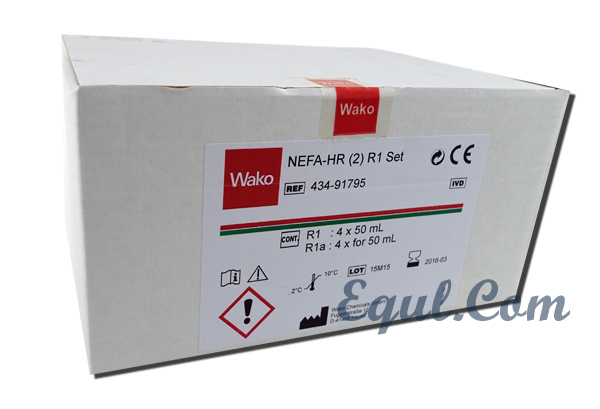商品描述
NEFA (non-esterified fatty acids) are free fatty acids (FFA) as opposed to triglycerides (esterified fatty acids) and measuring serum NEFA provides information about energy balance and fat mobilisation. The enzyme lipase catalyses the hydrolysis of triglycerides to release NEFA which are transported in the blood bound to albumin. In fasting states the concentration of NEFA typically increases as fatty acids are released by adipose tissue. Elevated levels of NEFA are often associated with type II diabetes and obesity.
NEFA measurement may be of interest to those investigating, diabetes mellitus, insulin resistance, obesity, metabolic syndrome, dairy herd health, nutrition and sports metabolism.
NEFA-HR(2) replaces the popular NEFA-C Kit which was withdrawn in 2010. The Wako NEFA-HR(2) reagents can be used to measure NEFA in serum and are suitable for both manual and automated methods. (A range of applications for automated chemistry analysers are available - please enquire. A manual microplate protocol is also available on request).
The Wako NEFA assay is a enzymatic, colorimetric method (ACS-ACOD-MEHA). Firstly the NEFA present in the test sample is converted to Acyl-CoA, AMP and pyrophosphoric acid (PPi) by the action of Acyl-CoA synthetase (ACS) in the presence of coenzyme A (CoA) and adenosine 5-triphosphate disodium salt (ATP). The resulting Acyl-CoA is then oxidised by the action of Acyl-CoA oxidase (ACOD) to yield 2,3-trans-Enoyl-CoA and hydrogen peroxide. In the presence of peroxidase (POD) the hydrogen peroxide yield a blue-purple pigment by quantitative oxidation condensation with 3-Methyl-N-Ethyl-N-(beta-Hydroxyethyl)-Aniline (MEHA) and 4-aminoantipyrine (4-AA). By measuring the absorbance of the blue-purple pigment at 546nm the concentration of NEFA in the sample can be calculated.
NEFA-HR(2) Reagent 1 (434-91795) is one component of the Wako NEFA Kit and should be used with Reagent 2 (436-91995) and the NEFA Standard (270-77000). The Wako NEFA assay has a measurable range of 0.01-4.00 mEq/L and is not significantly effected by haemolysis or ascorbic acid. Once reconstituted: reagent 1 is stable for 10 days when stored at 2-10C and reagent 2 is stable for up to 3 weeks at 2-10C.

